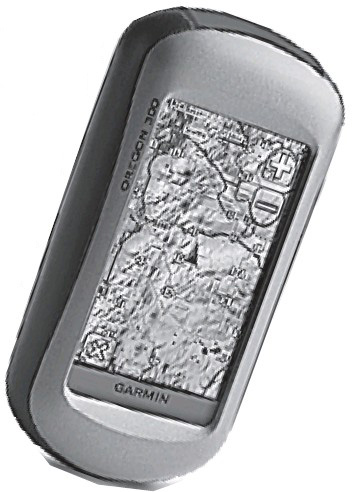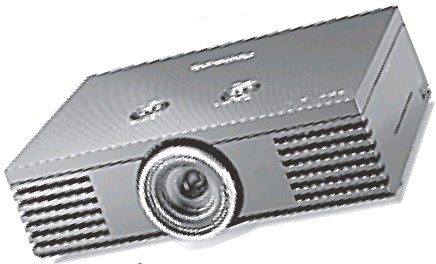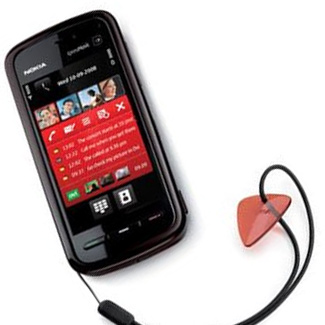Is new Google phone an Apple adversary?
Edward C. Baig
USA Today

Google’s G1 phone in GPS mode at the corner of 54th Street and Park Avenue in New York City. It shows a 360-degree view as you move your hand.
Will the first Google phone become the apple of your eye? We’ll have an inkling in six days when the much-anticipated T-Mobile G1 with Google goes on sale.
The G1 is a highly capable handheld computer with a responsive touch-screen like Apple’s hot-selling iPhone has. It also packs a slide-out physical keyboard. And it has multimedia picture messaging, a removable battery and other features the iPhone lacks. The mobile operating system at its core — what Google calls Android — is slick, if a little raw in some places.
But folks expecting iPhone-like glitter and glitz are bound to be disappointed. The hardware is unsexy. The phone performs better on T-Mobile’s fastest data network, but the carrier is only now rolling out that network in a lot of places. Even with access, Web pages took a long time to load.
What’s more, without such things as Outlook synchronization or Microsoft (MSFT) Exchange, the G1 is not a smart choice for businesses, not that T-Mobile is saying it is.
The battle for tech supremacy is increasingly going mobile. While Google products and services are embedded in other phones, Android marks the company’s entry into the high-stakes smartphone market dominated by Apple and Research In Motion.
The phone was built by Taiwanese manufacturer HTC. It costs $179 with a two-year T-Mobile voice plan, $399 without a contract. Data plans are reasonably priced: $25 or $35 a month, depending on whether you choose 400 messages or unlimited messaging. Plans include unlimited Web browsing and e-mail, plus access to T-Mobile Wi-Fi HotSpots.
T-Mobile says demand for the new smartphone is three times what it originally anticipated. But if the G1 hardware fails to ring your chimes, there’ll be lots of other Android-based phones coming. LG, Motorola and Samsung are among companies producing prototypes. Google CEO Eric Schmidt envisions thousands of Android devices some day.
Long term, Google hopes to make money with Android as it always has, through advertising. “None of the executives ever said to us, ‘First show us the business plan, and then we’ll tell you whether you can build Android or not,’ ” says Google’s Rich Miner, a co-founder of Android.
There are more than 3.3 billion active cellphones on the planet and several mobile platforms: RIM’s BlackBerry, Microsoft’s Windows Mobile, Apple’s OS X, Palm OS and Symbian. Android’s early incarnation stacks up favorably. The interface is flexible. I like such clever innovations as the menus and status notifications you drag down from the top of the screen like a window shades.
What you hear over and over from Google and T-Mobile about Android is “openness.” The promise is that developers can produce applications without interference. We’ll see.
“You can talk all day long about how flexible you’re going to be,” says Ross Rubin, director of industry analysis at NPD. “But if AT&T (T) for the iPhone or T-Mobile for this device feel that an application is going to cut significantly into revenue streams or circumvent or jeopardize the network, they’re not going to let that application exist.”
Openness is a difficult concept for consumers to grasp. “The fact that (Android) is an advanced, open, cheap operating system is important to the development community, but customers don’t buy operating systems,” says Paul Reddick, CEO of Handmark, a developer of mobile media apps and services for the BlackBerry, iPhone, Windows Mobile and other operating systems.
Reddick thinks Android will help breed the simple and elegant programs consumers crave: “We like our chances when it’s open.”
Here’s a closer look at the G1:
The basics
The G1 comes in black, bronze and, down the road, white. The 5.6-ounce device is thicker and heavier than the iPhone and a tad longer. The screen’s a little smaller. While it doesn’t do much for me aesthetically, the designers deserve props for physical buttons (and the usable keyboard) that complement the touch-screen.
You have several ways to perform different functions. For example, you can make a phone call by tapping the dialer icon on the touch-screen. Or you can access the dialer by pressing the send key below the screen. There’s also voice dialing, voice recognition and a speakerphone. Bluetooth is on hand (but no support for Bluetooth stereo). The phone can be used abroad.
Among the other purposeful physical keys are a handy back button, home button and convenient BlackBerry-like trackball for launching functions with one hand.
The “desktop” screen features a large clock and a few simple icons (Dialer, Contacts, Browser, Maps and T-Mobile’s MyFaves speed-dialing feature). Slide your finger to the left, and a Google search bar appears. If you run out of real estate for icons and such on the customizable front screen, you can find space elsewhere by sliding your finger in either direction. Tapping or dragging the tab at the bottom of the screen brings up a screenful of icons for programs, settings and so on that look an awful lot like the home screen on the iPhone.
You can view the screen in portrait or landscape mode, but the orientation doesn’t change when you rotate the device as with the iPhone. There is an accelerometer or motion sensor, though.
The good news is the G1 comes with removable memory for pictures, music or video (but, oddly, not applications). The bad news: I had a heckuva time removing it. And at 1 gigabyte, T-Mobile might have been more generous. The card can be expanded to 16 GB.
In lieu of a password to lock the phone (to prevent accidental calls or for security reasons), you can drag your finger to connect a series of on-screen dots in a designated pattern.
The Google connection
You must set up the phone with your Gmail account or create one. After that, your contacts, calendar events and e-mail are synced between your phone and computer. Google insists your privacy is protected. But Roger Entner, senior vice president at Nielsen IAG, says, “It’s potentially quite worrisome.”
You can use alternative e-mail accounts and instant-messaging programs, not just Gmail and Google Talk. And Google Maps (which relies on GPS) offers a very cool feature I only wish were available in more places: a street-level photograph of your whereabouts. You can get a 360-degree view of the street as you move your hand. It’s all synchronized with a built-in compass.
Network and Web browsing
T-Mobile says its high-speed data network is in more than 20 metropolitan markets, with more coming. You can go to www.t-mobile.com/coverage to see if you are in the faster 3G coverage area.
In Manhattan and northern New Jersey, I was sometimes in 3G and sometimes on the fringes of the slower Edge network. In 3G areas, Web pages loaded faster on the iPhone 3G than on the T-Mobile, sometimes two or three times so.
The G1 comes with a nice browser. You can drag pages around with your finger, tap the screen to zoom in or out or place a rectangle around the area of the screen you want to highlight. But I longed for the ability to spread my fingers or pinch a page to zoom like on the iPhone.
Market
The Market is Android’s answer to the iPhone App Store, and it’s still in beta. About three-dozen applications were available leading up to the launch, all free. You can browse by category (lifestyle, multimedia, productivity, etc.). Downloading these programs is a cinch.
I played a couple of games (Namco’s Pac-man and Glu Mobile’s Bonsai Blast). I also briefly checked out Ecorio, which calculates your carbon footprint when you travel.
At an Upper West Side bookstore, I tried a program called ShopSavvy. Using the G1’s camera, it can scan bar codes on books, DVDs and other products. You can then read reviews of the products or do quick price comparisons on the Web.
Multimedia
With 3 megapixels, G1’s camera has a higher resolution than the iPhone. It doesn’t shoot video. But its photo-viewer program isn’t nearly as sweet. Getting pictures off the computer and onto the G1 is less friendly, too.
An Amazon MP3 store is preinstalled for sampling and purchasing DRM-free music. There’s a bare-bones music player on the device. You can watch YouTube videos, but you’ll have to go into the Android Market to find a player for others.
The designers apparently didn’t learn from a mistake Apple made with the first iPhone. There’s no standard jack for using your own headphones without an adapter. That means sticking with the mini-USB headphones that are supplied.
Battery
The G1, unlike the iPhone, has a removable battery. T-Mobile says you’ll get up to five hours of talk time and more than five days of standby between charges. In heavy use, I got low-battery warnings by midafternoon.
On balance, the G1 is a fine first effort. I welcome the invasion of other Android phones.















